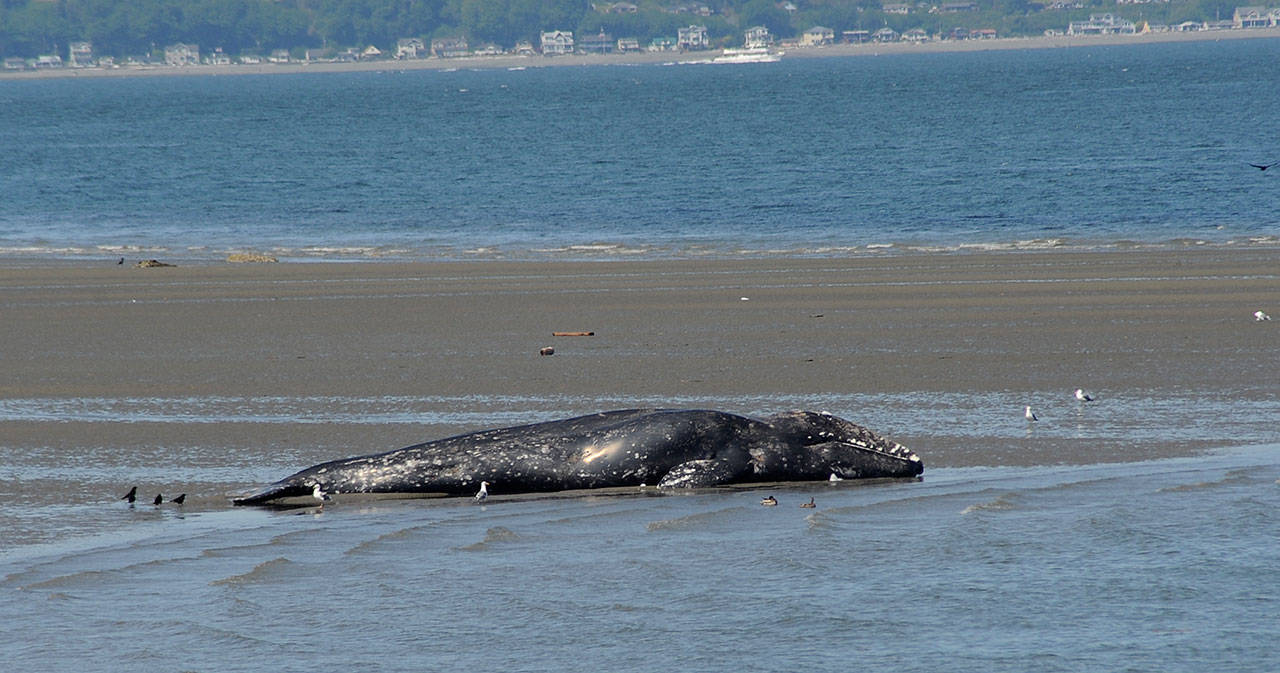In response to an increasing number of Eastern Pacific gray whales washing up dead, the Orca Network and City of Langley are calling for a moratorium on commercial ghost shrimp harvesting in North Puget Sound.
Ghost shrimp are a primary source of food for the large mammals that migrate 10,000 miles every spring from their calving lagoons in Baja, Mexico to their feeding grounds in the Bering Sea.
Ghost shrimp are also a source of income for commercial harvesters that sell it primarily for fish bait.
For the past 20 years, about a dozen of the migrating whales, known as the “Sounders” have routinely veered off into Saratoga Passage and remained for about six weeks filling up on ghost shrimp which burrow and breed in tidal sand. This past year, more gray whales have been seen in Whidbey’s local waters and some are staying longer, indications that there’s some change in the availability of food.
At least 60 gray whales have been found dead from Mexico to Alaska with 18 washing ashore in Washington. Scientists performing necropsies say the whales appear to have died of nutritional stress.
In 2018, the total death toll on the West Coast was 45 gray whales, including 10 in Washington, a little above average. Since it’s estimated that the number of reported strandings represents about 10 percent of the actual deaths, closer to 600 of the huge mammals may have died so far this year.
The Orca Network says it fears another large die-off of gray whales is occurring as it did in 1999 and 2000, when 651 strandings were reported along the Pacific Coast. Known as an Unusual Mortality Event, or UME, a large die-off among marine mammal populations demands immediate response, the organization said.
“Starvation with an unknown underlying cause” was likely responsible for the die off 20 years ago, the Cascadia Research Collective determined, and it may have led the whales to look for food around the tidal flats of Whidbey and Camano islands.
“Just as in previous years of widespread starvation, there is a new wave of individuals entering Puget Sound searching for food,” Susan Berta, Orca Network executive director, stated in her letter to the state’s Department of Natural Resources. “At least three individuals have died, with many more emaciated whales wandering through the area. A few new individuals have found the ghost shrimp in Saratoga Passage and remained there to feed.
“This suggests that the ghost shrimp beds in Puget Sound are a potentially lifesaving source of food for these whales,” she wrote.
Monday, the Langley City Council passed a resolution supporting a moratorium on ghost shrimp harvesting while the situation is studied.
Five years ago, the Orca Network and the City of Langley successfully convinced the state to stop the harvesting of ghost shrimp from 2014 to 2016 while a survey was conducted on its abundance. The state concluded there was enough of the tiny critters to go around for the transient whales and commercial wholesalers.
“Annual whale feeding and harvest combined account for only a small portion of the total shrimp stock available,” the report concluded.
These findings prompted DNR to lift the moratorium on harvesting, said Joe Smillie, a DNR spokesperson. Commercial harvesting of ghost shrimp is suspended from March through May when the gray whales scoop up the shrimp buffet by the ton — literally.
An adult gray whale that weighs 40 to 50 tons is estimated to consume 1,000 pounds of food or more every day.
Alisa Lemire Brooks, head of Orca Network’s surveillance team, was called May 5 to confirm the sighting of a deceased gray whale below Harborview Park in Everett, the third found along inland Puget Sound. A brief post-exam report posted by Cascadia Research Collective stated it was an adult 42-feet female gray whale; “cause of death was not immediately apparent but appeared consistent with nutritional stress.”
In April, an adult male gray whale was towed to Possession Point on Whidbey for a necropsy. The whale also appeared emaciated.
Gray whales could be malnourished because they didn’t eat enough in the North Pacific and Arctic last summer—a time typically spent gorging to build reserves for their migration, when they don’t eat. Or it could be a combination of factors, scientists speculate. Perhaps the gray whale population is growing so large that there’s not enough food to sustain them and/or ocean food webs are being disrupted by climate change.
Whatever the reason, the situation is especially troublesome for Berta and Orca Network’s legion of volunteers devoted to education and stewardship of all the ocean’s wondrous whale species.
Berta visited Baja’s San Ignacio Lagoon this past spring to see the mighty mammals up close from small boats.
“It is some of those whales who are now wandering into Puget Sound, emaciated and not doing well,” she said.
“A few of the lucky ones have found the ghost shrimp in North Puget Sound and have stopped to feed.
“For others, it is too late and they are near the end of their life, or don’t know where to find the ghost shrimp in North Puget Sound.”



